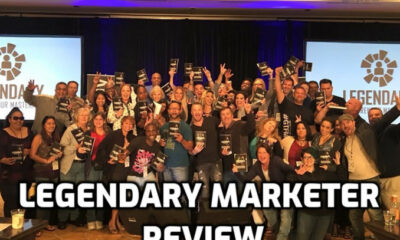MARKETING
How to Cure “Lonely Marketer Syndrome”

If you feel lonely as a digital marketer, you are not alone.
According to an ongoing survey conducted by CareerExplorer, marketing managers rate their career happiness at 3.1 out of 5 stars, which puts them at the bottom 40% of careers.
Why would a job that involves the most entertaining and fun aspects of business, that being growth, change, and interaction between business and customer, lead to such an unsatisfactory rating?
Further, how could a job that is perfectly suited for remote working still rate so low?
Why Marketers Are Unhappy
There are lots of reasons why someone could be unhappy with their job, but for now, let’s focus on the five core factors that generated a 3.1 star rating for marketing management. We’ll expand it a bit to accommodate soloprenuers/consultants and marketing agency owners as well:
- Compensation & Revenue
- Meaningfulness
- Personality Fit
- Work Environment
- Skill Utilization
Marketing Compensation & Revenue
Marketing Managers aren’t happy with their salary, even though they rate very high according to CareerExplorer’s survey. With an average of $135,000, marketing managers are the highest among similar careers like management consultants, investment fund managers, online merchants, operation managers, advertising managers, human resource managers, and project managers.
On the marketing business side, marketing agency revenue has continued to increase as well. According to Statista, digital advertising agency revenue grew from $5.69 billion in 2012 to $30.6 billion in 2022, an increase of 437% over 20 years (22% average annual increase).
Even so, they’re not happy!

Want to get certified in Content Marketing?
Leverage the tools and channels to predictably and profitably drive awareness, leads, sales, and referrals—EVERYTHING you need to know to become a true master of digital marketing. Click Here
Meaningfulness
Do marketing managers find their work meaningful? Most of them don’t according to the survey. They ranked meaningfulness at 2.7 out of 5 stars.
Personality Fit
How about the personality fit of people who are marketing managers? According to the survey, marketing managers rank fit as 3.8 out of 5 stars. Not bad considering! Still not great.
Work Environment
What about the work environment of marketing managers? That’s not bad as well, with a rating of 3.5 out of 5 stars. Even so, it could be better.
Skill Utilization
Finally, let’s talk about skill utilization. Do marketing managers feel that they’re using their skills to an adequate degree? They have skill utilization a 3.5 out of 5 stars. Again, not bad but not great either.
Overall, marketing professionals are missing on a lot of the key factors that lead to job and life satisfaction. Could there be a root cause for the disconnection?
Why the Marketing Profession is Awesome
We now have some insights into why the marketing profession may not be ideal, now let’s examine why it’s a really, really good job for some people. Let’s use those same survey factors to discuss.
Marketing Compensation & Revenue
Marketers make GOOD money. The survey by CareerExplorer said $135,000 average, which sounded high to me, however, Salary.com confirmed the range with the median being $113,582. No matter how you look at it, that is a great paycheck.
Meaningfulness
This is an abstract measure, but I think marketers have a huge opportunity to find meaning in marketing. Your job directly impacts the success of businesses. Businesses provide goods and services for their customers, while also providing paychecks for 47.5% of the population of the USA. What’s more meaningful than helping 58.9 million people to get paychecks?
Personality Fit
The marketing profession is perfect for people who like networking, extroverts that like building relationships, number-heads who love analytics, creatives who like constantly creating new media, attention-seekers who love interacting with audiences, and business people who like money. If your personality fits into any of those groups, you can find a good fit with marketing.
Work Environment
Marketers to work pretty much anywhere, PLUS there are tons of networking groups, expos, masterminds, courses, and other events to attend all year long all over the planet. You can work from home, work at an office, travel to clients’ locations, or take your laptop to the beach. A marketer can create their own work environment if they want to!
Skill Utilization
Few professions utilize a more dynamic list of skills than marketing. From technical to analytical to creative to relational, marketing requires the utilization of vast, complex, and evolving skillsets. You will never get bored with a marketing career because you never know what you’re going to need to know next. Better yet, you have the opportunity to create entirely new skillsets that no one has even considered before!
Loneliness is Bad for Productivity
With all that said, why are marketers still unhappy? I believe that the majority of marketers are more socially-minded than your average person. They crave connection between people. That could be connection with other marketers, connection between companies and their customers, and connection between owners and marketing professionals.
Problem is that since marketers can work anywhere, they often default to working remotely. As of mid-2022, Linkedin reported that jobs offering “remote work” increased 457% year over year. Remote working for marketing roles working remotely increased 177% in just the first half of 2022.
What do you get when you have primarily “social” people working remotely? You get lonely, and loneliness hurts productivity, creativity, and health.
Research by Dr. Vivek Murthy showed that loneliness and depression cost employers $44 billion a year. A study of remote workers found that one in five said “loneliness” was their biggest struggle.
So, while marketers are generally well paid and provided with challenging work that engages their personalities, they are faced with loneliness which greatly impairs work satisfaction. How do we fix the issue?

DOWNLOAD: The TikTok Ad Set Up Guide. Learn how to quickly create 16 TikTok ads in the least amount of time possible. Click Here
How to Fix Lonely Marketer Syndrome
The fix may seem obvious, but it is usually missed or approached too casually in most cases. Marketers need to become part of marketing communities. Not just any communities however, the ones that will truly impact their business and mindset will have the following characteristics:
#1: Formal Education Systems
Ideally, your community should have a proven set of frameworks that other marketers (preferably hundreds or even thousands) have used to succeed.
#2: In-Person & Online Events
Online events are great, but if there is no planned in-person event, you’re going to be missing an important part of connecting with others: seeing them “for real.” Your new community should have plans for in-person meeting opportunities, even if it’s just once a year.
#3: Broad & Narrow Specialty Groups
If you can find a network with a significant amount of people in your specific marketing niche, great! Just note that they should also be connected to broader topics so that you can learn more about interacting with entire marketing teams, not just people do the exact same work as you do.
#4: An Established History
Brand new groups are great, but there’s nothing worse than committing to a brand and having it disappear on you. Ideally, look for marketer communities that have been around for at least 5 years, but preferably longer.
#5: A Hierarchy for Ascension
The best communities provide opportunities for their members to grow and contribute, with the possibility of becoming a thought-leader, teacher, or contributor to the knowledge contained within an organization. Look for groups that have positions, awards, and prizes for top community members.
Where to Find the Right Marketer Community
Lucky for you, you’re already on the right website! DigitalMarketer has been growing their marketer community since 2008. With over 120,000 marketers completing courses, thousands of contributors, and over 1 million email subscribers, DigitalMarketer is the community of choice for marketers in over 60 different countries.
Whether you’re a beginner looking for your first certification with a Lab Membership, an agency owner looking to scale with our Certified Partner network, or a successful business owner looking to scale with the M3 Mastermind, DigitalMarketer is the place to be.
Beat Lonely Marketer Syndrome and join us today!
















You must be logged in to post a comment Login